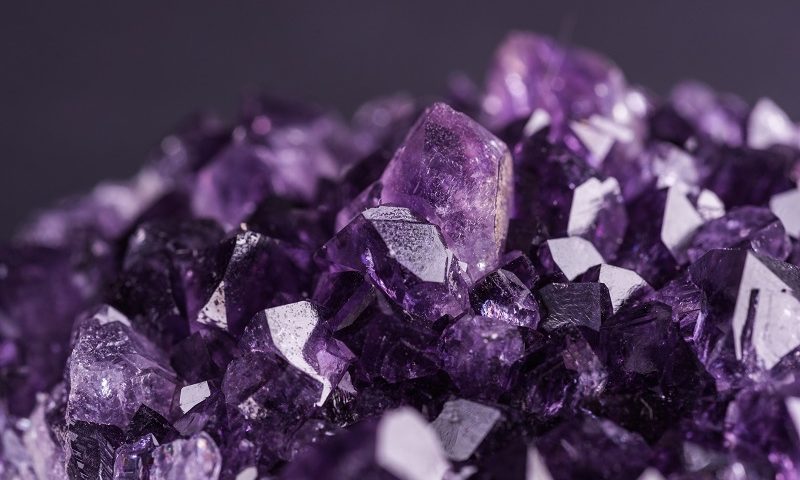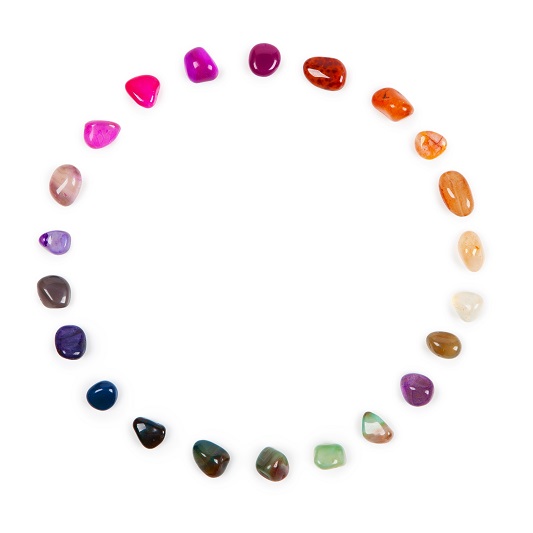Gemstone of the Week: Amethyst

Garnet, the gemstone of the week
21st December 2017
Gemstone of the Week – Tourmaline
12th January 2018A member of the Quartz family of minerals, Amethyst is one of the most precious and popular stones on the market today. The official birthstone for the month of February, the gem is often used within birthstone jewellery. Amethyst owes it’s vibrant purple colouring to aluminium and iron trace impurities. Without these impurities in its composition, the stone would be ordinary Transparent Quartz. The gemstone belongs to the macrocrystalline group of Quartz. Like all other stones in this category, Amethyst boasts translucent clarity and a strong lustre. Below, we explore the valuable gemstone in more detail.
How to Identify Amethyst
By the untrained eye, Amethyst is best identified by its vibrant colouring. The stone exhibits a violet-purple hue, that looks best in daylight. While the gem can still be identified under artificial light, its true colour will show best in natural light that is soft and warm – ideally, just after sunrise or before sunset. Fine-quality Amethyst is typically deep purple in colour, with intense saturation and minimal colour zoning. Specimens of this quality are precious, valuable, and highly sought after.
Typically, Amethyst can be correctly identified through its colour alone. The violet-purple hue is fairly unique, with few gemstones exhibiting the same tone. Because of this, Amethyst is rarely confused with other stones. Occasionally, Amethyst specimens may appear similar to Purple Sapphire or Purple Spinel; however, both of these stones are very rare, so confusion is kept to a minimum.
Golden Citrine Quartz is the sister stone of Amethyst. The only difference between the two stones is the level of iron impurities in their composition. Thankfully, the different levels of iron mean that the stones can be distinguished by their colouring. When Amethyst is heated to a high temperature, the iron impurities are reduced and can turn the stone into Golden Citrine. Low-grade Amethyst is often heat treated to produce Golden Citrine, due to the latter holding more value that bad-quality Amethyst.
Different Colours and Types of Amethyst
As mentioned previously, the colour of Amethyst is caused by iron and aluminium impurities. Because of this, Amethyst specimens will vary in colour, depending on the level of impurities in the stones composition. Typically, colours range from purple-violet to red-violet. The deep, intense colours hold the most value, especially rich purple specimens with red or blue flashes. A deep purple stone with red and blue flashes is often categorised as ‘Siberian Amethyst’. Stones of this nature usually command the highest prices.
Like most gemstones, Amethyst can be heat treated to improve its appearance. Typically, heating the stone to a high temperature will deepen the purple hue. This makes the stone more valuable and sought after. As touched upon above, further heating of the stone can transform Amethyst into Citrine Quartz. Heat treatment on Amethyst is most often used for this purpose. Below, we explore some of the trade names used for heat treated and natural Amethyst.
African Amethyst
As the name suggested, African Amethyst originates from Africa. Typically, this trade name applies to Amethyst with a darker colour.
Amethyst Quartz
Amethyst Quartz is best described as a mixture of Amethyst and Clear Quartz. Typically, this type of stone is purple on top and clear or white on the bottom. Amethyst Quartz is often used for beaded bracelets.
Brazilian Amethyst
Again, as the name suggests, Brazilian Amethyst originates from Brazil. This term is sometimes used in the gem trade to describe South American Amethyst, too.
Green Amethyst
Green Amethyst is actually just Green Quartz. Also known as ‘Prasiolite’, the stone is produced by heat treating low-grade Amethyst
Siberian Amethyst
Deep in colour, Siberian Amethyst originates from Russia. Typically, stones of this nature are dark purple with flashes of red and blue. They are the most valuable type of Amethyst on the market today.
Where is Amethyst Found?
Today, the most notable Amethyst deposits are in Brazil. The most important deposits are seen as being the ‘Palmeira’ Amethysts of Rio Grande do Sul and the ‘Maraba’ Amethysts of Para. Other deposits can be found around the world, with notable sources being Bolivia, Canada, India, Madagascar, Mexico, Myanmar, Namibia, Russia, Sri Lanka, United States, Uruguay and Zambia.
Healing Properties of Amethyst
Amethyst is seen as being a powerful and protective gemstone. In ancient times, the stone was used to overcome physical addiction and addictive relationships. Because of this, Amethyst became known as the ‘Stone of Sobriety’. Today the gem is used to transform negative energy into positive.
In crystal healing, Amethyst is thought to open and cleanse the Crown Chakra. In addition to encouraging access to the divine, the opening of the Crown Chakra can enhance spiritual awareness and wisdom. The gemstone can cleanse and repair body aura, as well as encouraging divine energy.
Physically, Amethyst can be used to aid the discomfort associated with headaches; because of this, the stone is ideal for those suffering from tension and migraines. Great for those who have trouble sleeping, the gem is also believed to reduce nightmares and relieve insomnia.
In Summary
Beautiful Amethyst is popular worldwide. Today, the most notable deposits of the stone are found in Brazil. Loved for its violet-purple hue and translucent clarity, fine-quality Amethyst is often used in designer jewellery. Whether you’re hoping to use the stone for its benefits within crystal healing or you’re looking for a beautiful new addition to your jewellery collection, purchase a good-quality piece of Amethyst to reap the benefits.




